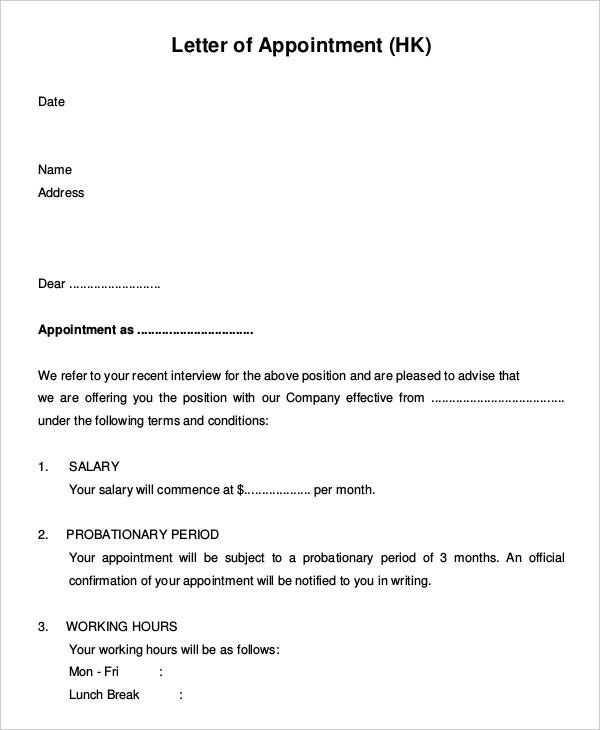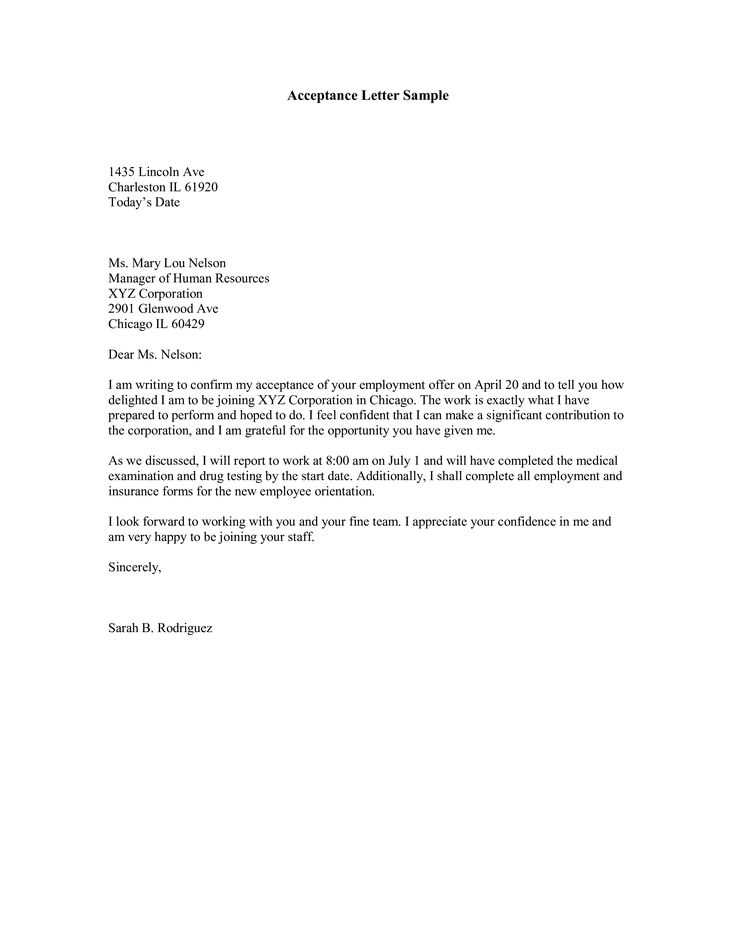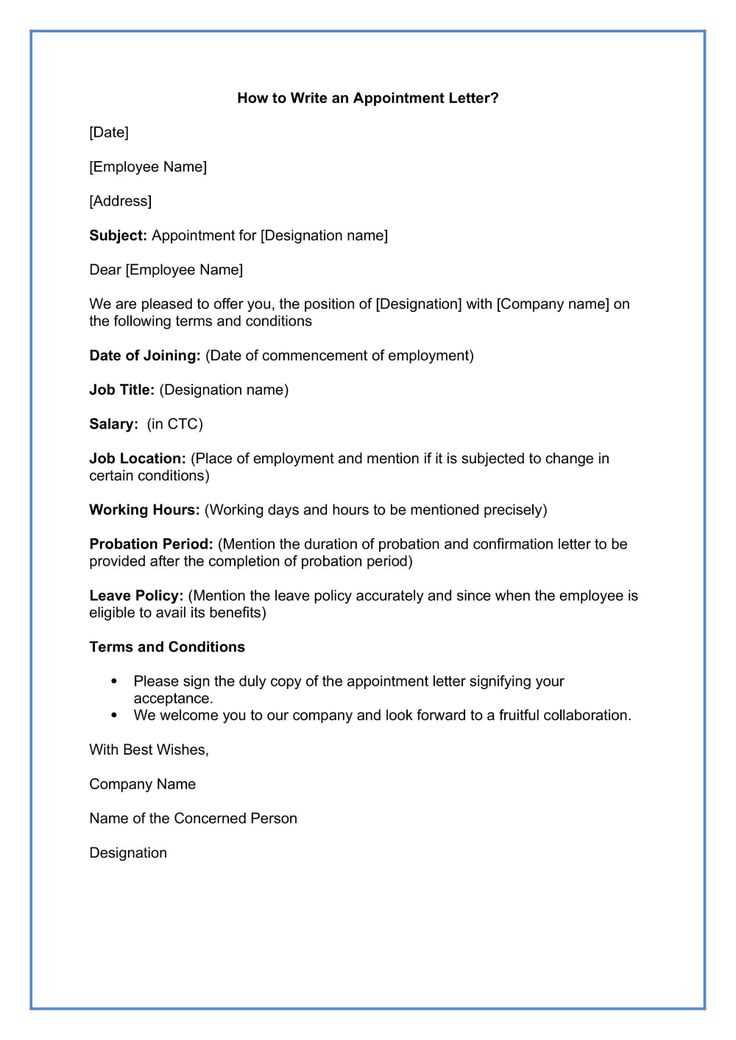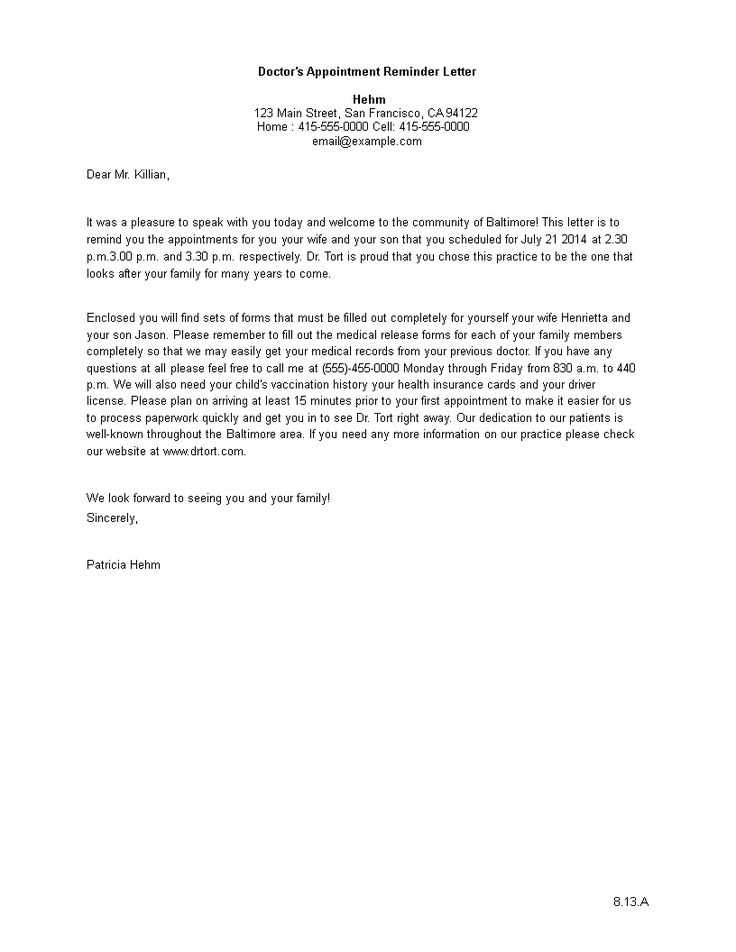Appointment Letter Template for Professional Use

Creating a formal written agreement is a crucial step in establishing clear expectations between an employer and a new hire. This document serves as a foundation for a professional relationship, outlining the terms, responsibilities, and compensation details. By providing all necessary information in a clear and structured manner, both parties are better equipped to start their collaboration smoothly.
Ensuring that the document is well-crafted is key to avoiding misunderstandings. A properly structured message provides clarity on the role, expectations, and other essential points of the job. It not only reflects the professionalism of the organization but also assures the candidate of the company’s commitment to transparency and fair dealings.
Understanding how to draft this document effectively helps organizations ensure that the process is smooth and free from legal or communication issues. This written agreement is vital in safeguarding both the employer and the employee, helping to avoid potential disputes and promoting a positive work environment from the very start.
Comprehensive Employment Offer Document
Creating a well-structured agreement is essential for any business looking to formalize a hiring process. This written communication outlines the role, responsibilities, compensation, and other key details to ensure both parties are aligned before the employment begins. A comprehensive agreement not only clarifies the expectations but also sets the tone for a professional working relationship.
Key Components of the Document
A clear and detailed agreement should cover several important areas to prevent any confusion later. The following points are essential:
- Job Title and Description: Clear description of the position, including primary duties and tasks.
- Compensation and Benefits: Outline of the salary, bonuses, and benefits provided.
- Work Schedule: Details of working hours, shifts, and any expectations regarding availability.
- Start Date: Specific date when the employee is expected to begin their role.
- Probationary Period: Terms and conditions regarding initial performance evaluation, if applicable.
Formatting for Clarity
While the content is crucial, how the document is organized plays a significant role in its effectiveness. Using a structured approach ensures that the information is easy to digest and reference later. Here are some best practices for formatting:
- Simple Language: Avoid legal jargon and overly complex phrases; the information should be clear and understandable.
- Professional Tone: Maintain a formal and respectful tone throughout the document.
- Bullet Points: Use bullet points or numbered lists for easy-to-read sections, such as responsibilities and benefits.
- Consistent Layout: Ensure uniformity in font size, spacing, and margins for a neat and professional presentation.
Why an Employment Confirmation Document Matters

Establishing a formal written record between an employer and a new hire is crucial for setting clear expectations and preventing misunderstandings. This document serves as a concrete confirmation of the terms agreed upon during the hiring process, making it easier for both parties to reference their responsibilities and commitments. It helps ensure that the professional relationship starts on the right foot, fostering trust and clarity.
Benefits for Both Parties
For both the employee and the employer, a well-crafted document offers several important advantages:
| For Employers | For Employees |
|---|---|
| Provides legal protection in case of disputes. | Clarifies job expectations, reducing ambiguity. |
| Ensures transparency in compensation and benefits. | Assures job security and a clear understanding of role responsibilities. |
| Acts as a record of employment terms. | Outlines career growth opportunities and evaluation criteria. |
Setting Clear Expectations

A clear document is not only essential for legal reasons but also helps to foster a professional atmosphere. It sets clear boundaries and defines the roles and expectations for both the employer and the employee. This clarity reduces the chances of conflicts and makes sure both parties are on the same page about the work arrangement.
Essential Information to Include
When creating a formal employment agreement, it is crucial to ensure that all relevant details are covered to avoid confusion and protect both parties. By including the right information, you provide a clear understanding of the terms and set expectations for the professional relationship. This document should cover several key aspects that both the employer and employee will reference throughout the course of employment.
Key Elements to Include
To make sure the document is comprehensive, the following points should always be addressed:
- Employee Information: Full name, address, and other personal details of the employee.
- Position Title: Clear definition of the role the employee will hold and the associated responsibilities.
- Start Date: The exact date the employee is expected to begin their duties.
- Compensation and Benefits: Salary, bonuses, allowances, and any benefits offered, such as health insurance.
- Work Schedule: The expected hours, shifts, and any flexibility in working arrangements.
- Probation Period: Duration of any probationary period and associated terms or evaluations.
Additional Information
In some cases, additional clauses may be necessary to clarify other aspects of the employment agreement:
- Non-Disclosure Agreements (NDAs): If confidentiality is crucial for the role, a confidentiality clause may be included.
- Termination Terms: Conditions under which either party can terminate the employment relationship.
- Leave Policies: Details regarding vacation, sick leave, and other types of leave the employee is entitled to.
How to Customize the Document
Customizing a formal agreement is essential to ensure it aligns with both the company’s policies and the specific needs of the role. By tailoring the content to the individual employee and the position offered, you can create a more personalized and accurate document that reflects the terms of employment. This customization process enhances clarity and helps avoid any misunderstandings regarding job expectations.
The following steps can guide you in personalizing the agreement effectively:
- Update Personal Information: Ensure the employee’s full name, address, and other relevant details are accurately filled in.
- Define the Job Role: Clearly state the title and detailed description of the employee’s responsibilities, making it specific to the role being offered.
- Adjust Compensation Details: Include the agreed-upon salary, bonuses, and benefits, customizing this section to reflect the specific package provided to the employee.
- Include Company-Specific Policies: Adapt any sections relating to company policies, such as work hours, probation period, or leave entitlements, to reflect the organization’s approach.
- Clarify Legal Terms: If applicable, customize any clauses related to confidentiality, non-compete agreements, or intellectual property based on the employee’s position and responsibilities.
Avoiding Common Errors in Documents
Creating a formal document is an important task that requires attention to detail to avoid mistakes that could lead to misunderstandings or legal complications. Even small errors can affect the clarity and effectiveness of the agreement. Being aware of the most common mistakes and taking steps to avoid them will ensure the document is professional and legally sound.
Here are some common errors to watch out for:
- Incorrect Information: Double-check all personal details, such as the employee’s name, address, and contact information, to ensure they are accurate.
- Vague Job Descriptions: Be specific about the role and responsibilities, avoiding overly general terms that could lead to confusion about job expectations.
- Ambiguous Compensation Terms: Clearly state the salary, bonuses, and benefits. Avoid any ambiguity that might arise from vague wording or missing details.
- Missing Dates: Ensure that the start date, probation period, and other important dates are clearly specified to avoid confusion or delays.
- Unclear Legal Clauses: Any legal language or clauses, such as confidentiality or termination terms, should be clearly written and free from complex or confusing jargon.
Understanding Legal Implications

Creating a formal employment agreement carries significant legal responsibilities for both parties involved. This document serves not only as a record of mutual expectations but also as a legally binding contract. Understanding the legal implications of the terms within the document is essential to ensure compliance with labor laws and prevent potential disputes down the line.
Here are several key areas to consider when drafting such an agreement:
- Employment Laws: Ensure that the terms comply with local labor laws, including minimum wage, working hours, and termination procedures.
- Contractual Obligations: Clearly outline the rights and duties of both the employer and the employee to avoid any legal challenges related to breach of contract.
- Termination Clauses: Specify conditions under which either party can terminate the agreement, ensuring it aligns with applicable employment regulations.
- Confidentiality and Non-Compete: If applicable, include provisions to protect sensitive information and prevent the employee from competing with the business during or after employment.
- Dispute Resolution: Outline procedures for resolving conflicts, such as mediation or arbitration, to avoid costly legal battles.
Best Practices for Document Formatting
Proper formatting is essential when creating a formal document, as it ensures readability and professionalism. Clear structure, consistent style, and attention to detail not only make the content easy to follow but also help convey a sense of legitimacy and respect. Adhering to best practices when structuring the document will enhance its effectiveness and avoid unnecessary confusion.
Here are some best practices to follow:
- Use Clear Sections: Divide the content into distinct sections, such as introduction, role description, compensation, and legal terms, for easy navigation.
- Consistent Font Style and Size: Stick to a professional font, such as Arial or Times New Roman, in a readable size (e.g., 12-point) to maintain consistency and legibility.
- Proper Margins and Spacing: Ensure the document has adequate margins (typically 1 inch) and line spacing (1.5 or double) for a clean, organized layout.
- Headings and Subheadings: Use clear, concise headings and subheadings to break up the text and highlight key points. This improves readability and guides the reader through the content.
- Professional Tone: Maintain a formal and respectful tone throughout, avoiding overly casual language or overly complex jargon.